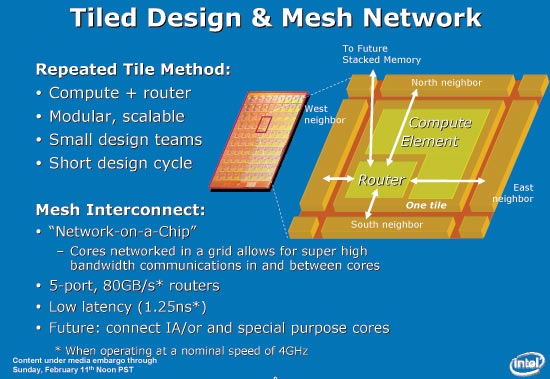The Era of Tera: Intel Reveals more about 80-core CPU
by Anand Lal Shimpi on February 11, 2007 5:44 PM EST- Posted in
- CPUs
The Network
Each of the 80 tiles in the teraflops chip are identical, which helps simplify design and manufacturing. As we mentioned earlier, each tile has two primary components: the Processing Engine (PE) and a 5-port router.
The router on each tile is used to pass data and instructions between tiles in the network. The tile passing the data doesn't have to even work on the data, it can simply be used for its router and not its PE. As such, the PE on a tile can be powered down independently of its router to save power.
The router on each tile features five 39-bit ports that can offer a total bandwidth of 80GB/s if the chip is operating at 4GHz; the data busses are double pumped. Of the 3mm^2 tile die area, only 0.34mm^2 is used for the router making it reasonable to have 80 of them on a single chip.
Four of the five ports are used for connecting to other titles as you can see from the slide below:

The fifth port is used for connecting to stacked memory, which Intel tells us we'll be hearing about in another quarter or so. For heat reasons the stacked memory will actually be mounted below the teraflop processor die.
The main attraction of the router and the network layout of the chip in general is that the PE can be replaced by anything, including an x86 core or a special purpose core (e.g. DSP or hardware encryption engine). Instead of a network of 80 tiles, you can imagine one with maybe 12, six of which are general purpose x86 cores and the rest are specialized cores to handle things like 3D rendering, TCP/IP offload, encoding, etc... The router network works for 80 cores, and making it work for any other number of cores, whether less or more, is trivial.










25 Comments
View All Comments
Navitron - Monday, February 12, 2007 - link
In the words of bill gates "No one will need more than 637 kb of memory for a personal computer." You sound just like him :P Don't bash the technology just because "right now" we don't need it. But what about in 10-20 years, you still think your core 2 duo is gonna cut it in 15 years? Can a IBM 80386 run doom 3? will todays AMD and Intels run -insert game here- 10 years from now.So don't assume just because we don't need it now doesn't mean we wont need it in 3 years.
cscpianoman - Sunday, February 11, 2007 - link
The average consumer might not need it, but large industries will be grabbing at these things faster than you can imagine. Think of health care, for example, the trend is to move towards genetic manipulations/prescreening. These industries want to download a person's entire genetic information, process it, and return it to you with the results of Alzhiemer's, cancer, and heart problems in a matter of minutes. Furthermore, the entertainment industry would love to create more special effects and render them that much faster. I'm sure if they could Pixar would already be placing an order for these. There are hundreds of applications out there that require the power and capability of multi-cores. Sure the consumer may not need it, but the consumer only accounts for less than approx. 5% of what Intel, AMD or whoever makes.mino - Sunday, February 11, 2007 - link
They need it (to sell). Period.Justin Case - Sunday, February 11, 2007 - link
In other words, Intel is doing the same that IBM and AMD (with Cell and Torrenza + Fusion), only with some made-up numbers and more Powerpoint charts. Unless they vastly improve their compilers' paralellization, or come up with a full suite of software optimized for multi-core chips (80? It's hard enough to take full advantage of 4!), this will remain something that "can be done", but which most people will have no use for.joex444 - Sunday, February 11, 2007 - link
attack switch